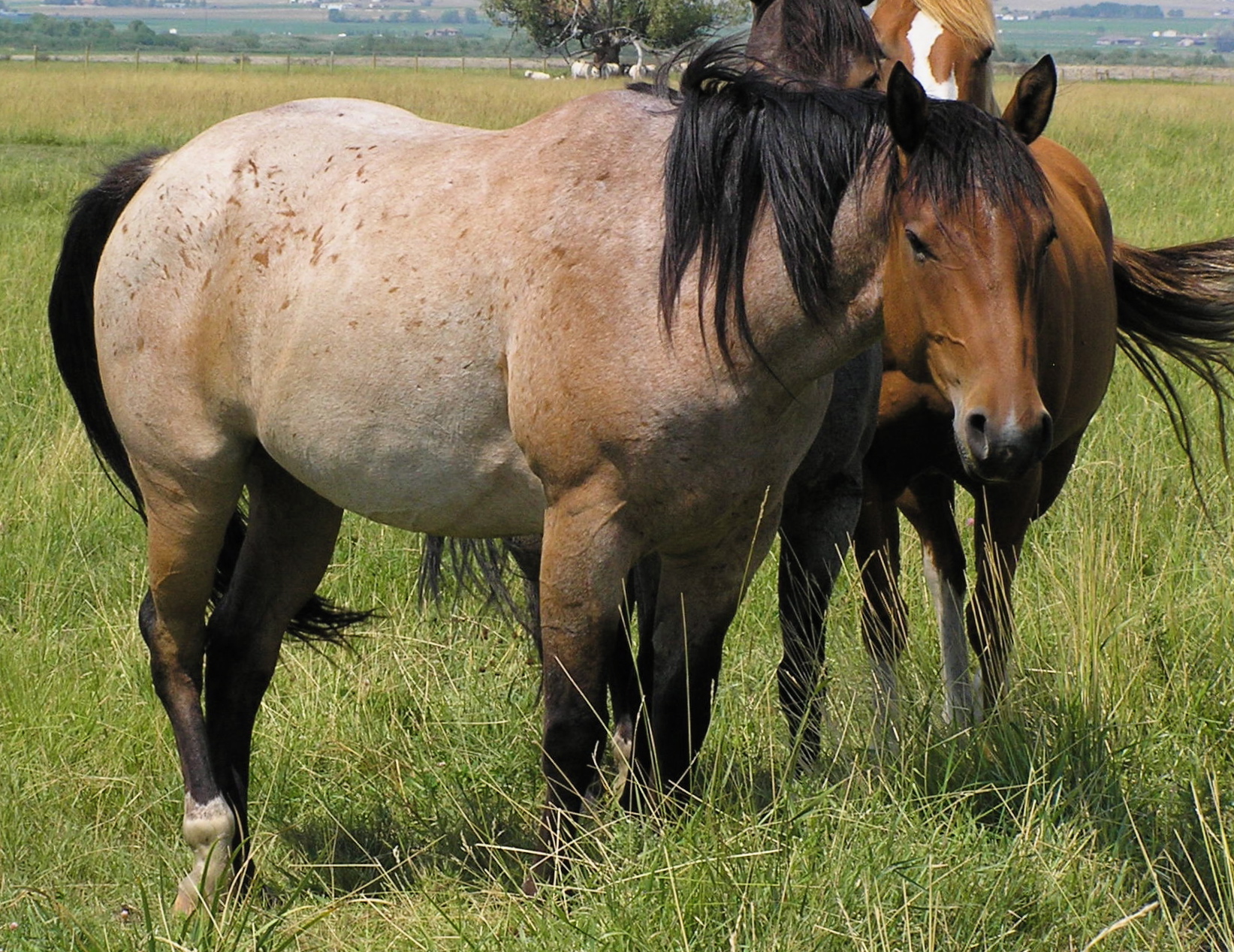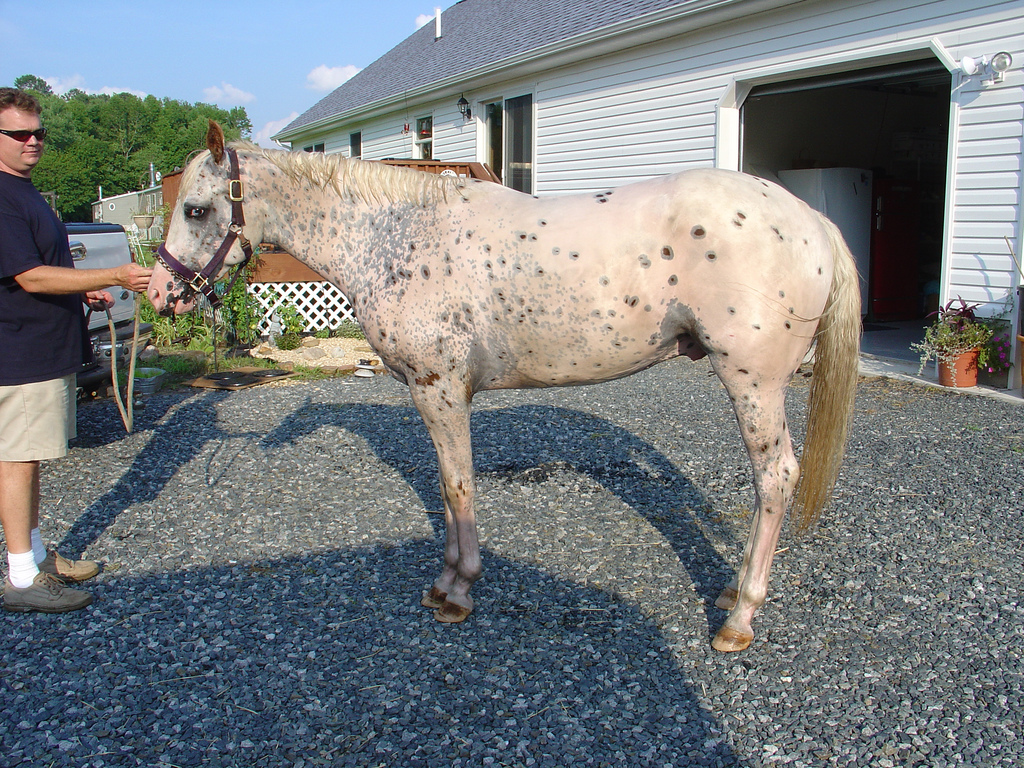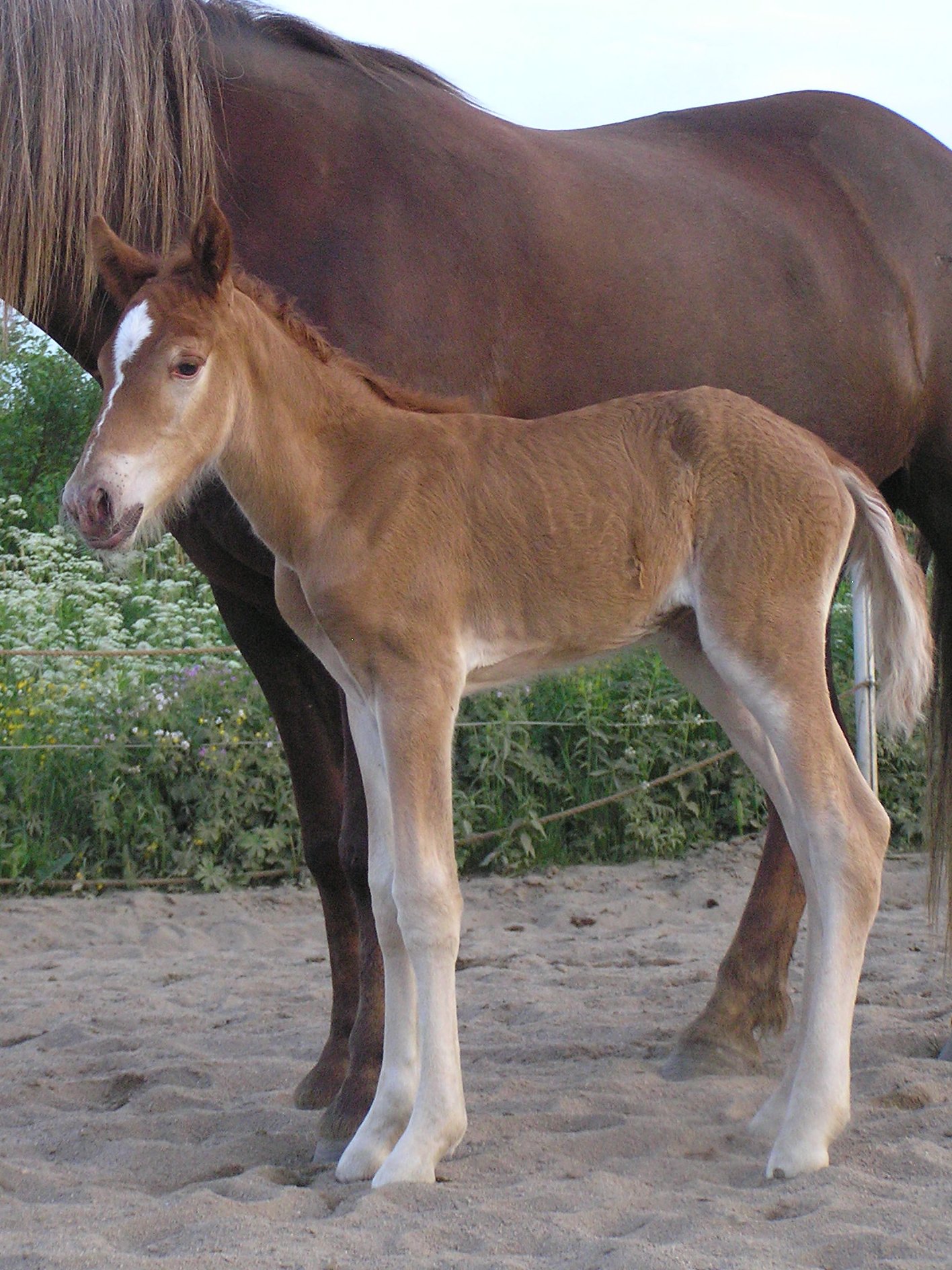|
Roan (colour)
Roan is a coat color found in many animals, including horses, cattle, antelope, cats and dogs. It is defined generally as an even mixture of white and pigmented hairs that do not "gray out" or fade as the animal ages."''roan'', ''a''. and ''n.1''" Oxford English Dictionary. 2nd edition 1989. OED Online. Oxford University Press. 3 June 2008. . There are a variety of genetic conditions which produce the colors described as "roan" in various species. Roan horses A horse with intermixed white and colored hairs of any color is usually called a roan. However, such mixtures, which can appear superficially similar, are caused by a number of separate genetic factors. Identifiable types of roans include true or classic roan, varnish roan, and rabicano, though other currently unknown factors may be responsible for ambiguous "roaning." Gray horses, which become lighter as they age until their hair coat is nearly completely white, may be confused with roans when they are young. Duns, ... [...More Info...] [...Related Items...] OR: [Wikipedia] [Google] [Baidu] |
Horse
The horse (''Equus ferus caballus'') is a domesticated, one-toed, hoofed mammal. It belongs to the taxonomic family Equidae and is one of two extant subspecies of ''Equus ferus''. The horse has evolved over the past 45 to 55 million years from a small multi-toed creature, '' Eohippus'', into the large, single-toed animal of today. Humans began domesticating horses around 4000 BCE in Central Asia, and their domestication is believed to have been widespread by 3000 BCE. Horses in the subspecies ''caballus'' are domesticated, although some domesticated populations live in the wild as feral horses. These feral populations are not true wild horses, which are horses that have never been domesticated. There is an extensive, specialized vocabulary used to describe equine-related concepts, covering everything from anatomy to life stages, size, colors, markings, breeds, locomotion, and behavior. Horses are adapted to run, allowing them to quickly escape predator ... [...More Info...] [...Related Items...] OR: [Wikipedia] [Google] [Baidu] |
Allele
An allele is a variant of the sequence of nucleotides at a particular location, or Locus (genetics), locus, on a DNA molecule. Alleles can differ at a single position through Single-nucleotide polymorphism, single nucleotide polymorphisms (SNP), but they can also have insertions and deletions of up to several thousand base pairs. Most alleles observed result in little or no change in the function or amount of the gene product(s) they code or regulate for. However, sometimes different alleles can result in different observable phenotypic traits, such as different pigmentation. A notable example of this is Gregor Mendel's discovery that the white and purple flower colors in pea plants were the result of a single gene with two alleles. Nearly all multicellular organisms have two sets of chromosomes at some point in their biological life cycle; that is, they are diploid. For a given locus, if the two chromosomes contain the same allele, they, and the organism, are homozygous with re ... [...More Info...] [...Related Items...] OR: [Wikipedia] [Google] [Baidu] |
Leopard Complex
The leopard complex is a group of genetically related Equine coat color, coat patterns in horses. These patterns range from progressive increases in interspersed white hair similar to Gray (horse), graying or Roan (horse), roan to distinctive, Dalmatian (dog), Dalmatian-like leopard (pattern), leopard spots on a white coat. Secondary characteristics associated with the leopard complex include a white sclera around the eye, striped horse hoof, hooves and mottling, mottled skin. The leopard complex gene is also linked to abnormalities in the eyes and vision. These patterns are most closely identified with the Appaloosa and Knabstrupper breeds, though its presence in breeds from Asia to western Europe has indicated that it is due to a very ancient mutation. Leopard complex patterns Coat patterns in the leopard complex range from being hardly distinguishable from an unaffected coat, to nearly pure white. Unlike most other Pinto horse, spotting patterns, the spotting and especially th ... [...More Info...] [...Related Items...] OR: [Wikipedia] [Google] [Baidu] |
Koning Albert KWPN Stallion
Koning is the Dutch and Afrikaans word for "king" and thus may refer to the King of the Netherlands or the King of Belgium. Old spelling variations include Coning, Coninck, Köning, Koninck, Koningh, Konink, and Kooning. "Koning" and "De Koning" are quite common Dutch surnames and may refer to: * Ans Koning (1923–2006), Dutch javelin thrower *Arthur Koning (1944–2015), Dutch rower * Christina Koning (b. 1954), British novelist and short story writer * Elisabeth Koning (1917–1975), Dutch sprinter * Elisabeth Johanna Koning (1816–1887), Dutch painter * Gerry Koning (b. 1980), Dutch footballer *Hans Koning (1921–2007), Dutch writer * Henk Koning (1933–2016), Dutch tax official and politician *Henry Koning (b. 1960), Dutch sailor * Jacob Koning, alternate spelling of Jacob Koninck (c.1615–c.1695), Dutch painter (brother of Philips) * Jean Koning (b. 1976), Dutch actor, director, musician and author * Karen Koning AbuZayd (b. 1941), American diplomat *Marcel Koning (b ... [...More Info...] [...Related Items...] OR: [Wikipedia] [Google] [Baidu] |
Grullo
Grullo (pronounced GREW-yo) or grulla is a color of horses in the dun family, characterized by tan-gray or mouse-colored hairs on the body, often with shoulder and dorsal stripes and black barring on the lower legs. The genotype for grulla horses is a black base with dun dilution. In this coloration, each individual hair is mouse-colored, unlike a roan, which is composed of a mixture of dark and light hairs. The several shades of grulla are informally referred to with a variety of terms, including black dun, blue dun, slate grulla, silver grulla or light grulla, silver dun, or lobo dun. Silver grulla may also refer to a grulla horse with silver dapple, regardless of shade. In terms of equine coat color genetics, all of these shades are based on the dun gene acting as a dilution gene over the black gene. Because the grulla color is not due to the gray gene, a grulla horse remains the same basic color from birth, though some minor shade variation may occur from summer to winte ... [...More Info...] [...Related Items...] OR: [Wikipedia] [Google] [Baidu] |
Black (horse)
Black is a hair coat color of horses in which the entire hair coat is black. It is not uncommon to mistake dark chestnuts or bays for black. Black horses have dark brown eyes, black skin, and wholly black hair coats without any areas of permanently reddish or brownish hair. They may have pink skin beneath any white markings under the areas of white hair, and if such white markings include one or both eyes, the eyes may be blue. Many black horses "sun bleach" with exposure to the elements and sweat, and therefore their coats may lose some of their rich black character and may even resemble bay or seal brown, though examination of the color of hair around the eyes, muzzle and genitals will determine color. Some breeds of horses, such as the Friesian horse, Murgese and Ariegeois (or Merens), are almost exclusively black. Black is also common in the Fell pony, Dales pony, Ostfriesen and Alt-Oldenburger, Kladruber, and Groningen. Visual identification When identifying ... [...More Info...] [...Related Items...] OR: [Wikipedia] [Google] [Baidu] |
Bay (horse)
Bay is a equine coat color, hair coat color of horses, characterized by a reddish-brown or brown body color with a black point coloration on the mane (horse), mane, tail (horse), tail, Pinna (anatomy), ear edges, and lower legs. Bay is one of the most common coat colors in many horse breeds. The black areas of a bay horse's hair coat are called "black points", and without them, a horse is not a bay horse. Black points may sometimes be covered by white horse markings, markings; however such markings do not alter a horse's classification as "bay". Bay horses have dark skin – except under white markings, where the skin is pink. Genetically, bay occurs when a horse carries both at least one dominant Agouti gene and at least one dominant Extension gene. While the basic genetics that create bay coloring are fairly simple, the genes themselves and the mechanisms that cause shade variations within the bay family are quite complex and, at times, disputed. The genetics of dark shades ... [...More Info...] [...Related Items...] OR: [Wikipedia] [Google] [Baidu] |
Chestnut (coat)
Chestnut is a hair coat color of horses consisting of a reddish-to-brown coat with a mane and tail the same or lighter in color than the coat. Chestnut is characterized by the absolute absence of true black hairs. It is one of the most common horse coat colors, seen in almost every breed of horse. Chestnut is a very common coat color but the wide range of shades can cause confusion. The lightest chestnuts may be mistaken for palominos, while the darkest shades can be so dark they appear black. Chestnuts have dark brown eyes and black skin, and typically are some shade of red or reddish brown. The mane, tail, and legs may be lighter or darker than the body coat, but unlike the bay they are never truly black. Like any other color of horse, chestnuts may have pink skin with white hair where there are white markings, and if such white markings include one or both eyes, the eyes may be blue. Chestnut foals may be born with pinkish skin, which darkens shortly afterwards. Chest ... [...More Info...] [...Related Items...] OR: [Wikipedia] [Google] [Baidu] |
Equine Coat Color
Horses exhibit a diverse array of coat colors and distinctive horse markings, markings. A specialized vocabulary has evolved to describe them. While most horses remain the same coat color throughout life, some undergo gradual color changes as they age. Most horse markings, white markings are present at birth, and the underlying skin color of a healthy horse does not change. Certain coat colors are also associated with specific breeds, such as the Friesian, which is almost exclusively black. The basic outline of equine coat color genetics has largely been resolved, and DNA tests to determine the likelihood that a horse will have offspring of a given color have been developed for some colors. Discussion, research, and even controversy continue about some of the details, particularly those surrounding spotting patterns, color sub-shades such as "sooty (gene), sooty" or "flaxen gene, flaxen", and horse markings, markings. Basic coat colors The two basic pigment colors of horse hair ... [...More Info...] [...Related Items...] OR: [Wikipedia] [Google] [Baidu] |
Chromosome
A chromosome is a package of DNA containing part or all of the genetic material of an organism. In most chromosomes, the very long thin DNA fibers are coated with nucleosome-forming packaging proteins; in eukaryotic cells, the most important of these proteins are the histones. Aided by chaperone proteins, the histones bind to and condense the DNA molecule to maintain its integrity. These eukaryotic chromosomes display a complex three-dimensional structure that has a significant role in transcriptional regulation. Normally, chromosomes are visible under a light microscope only during the metaphase of cell division, where all chromosomes are aligned in the center of the cell in their condensed form. Before this stage occurs, each chromosome is duplicated ( S phase), and the two copies are joined by a centromere—resulting in either an X-shaped structure if the centromere is located equatorially, or a two-armed structure if the centromere is located distally; the jo ... [...More Info...] [...Related Items...] OR: [Wikipedia] [Google] [Baidu] |
Mutation
In biology, a mutation is an alteration in the nucleic acid sequence of the genome of an organism, virus, or extrachromosomal DNA. Viral genomes contain either DNA or RNA. Mutations result from errors during DNA or viral replication, mitosis, or meiosis or other types of damage to DNA (such as pyrimidine dimers caused by exposure to ultraviolet radiation), which then may undergo error-prone repair (especially microhomology-mediated end joining), cause an error during other forms of repair, or cause an error during replication ( translesion synthesis). Mutations may also result from substitution, insertion or deletion of segments of DNA due to mobile genetic elements. Mutations may or may not produce detectable changes in the observable characteristics ( phenotype) of an organism. Mutations play a part in both normal and abnormal biological processes including: evolution, cancer, and the development of the immune system, including junctional diversity. Mutati ... [...More Info...] [...Related Items...] OR: [Wikipedia] [Google] [Baidu] |







